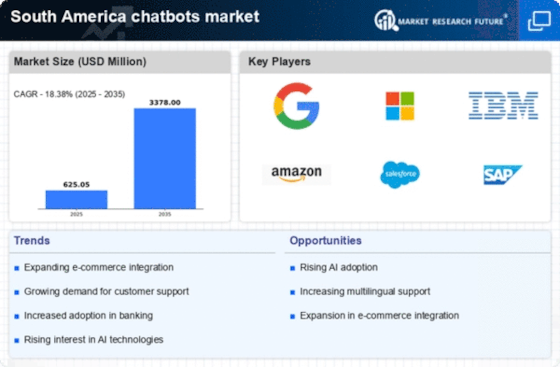Growth of Mobile Commerce
The rapid growth of mobile commerce in South America is significantly influencing the chatbots market. As more consumers turn to mobile devices for shopping, businesses are compelled to adapt their customer engagement strategies. In 2025, mobile commerce is expected to account for over 50% of total e-commerce sales in the region. This shift necessitates the integration of chatbots that can provide instant assistance and personalized recommendations to mobile users. The chatbots market is thus poised for expansion as companies seek to enhance user experiences through mobile-friendly chatbot solutions, ultimately driving sales and customer loyalty.
Expansion of Internet Connectivity
The expansion of internet connectivity across South America is a critical driver for the chatbots market. With increasing access to high-speed internet, more consumers are engaging with digital platforms, creating a fertile ground for chatbot implementation. As of 2025, internet penetration in the region is projected to reach approximately 75%, facilitating a broader audience for businesses to interact with. This enhanced connectivity allows companies to deploy chatbots that can operate effectively across various platforms, including websites and mobile applications. Consequently, the chatbots market is likely to benefit from this trend, as businesses leverage improved internet access to enhance customer interactions and service delivery.
Increased Focus on Personalization
The increasing focus on personalization in customer interactions is driving the chatbots market in South America. Businesses are recognizing the importance of tailoring experiences to individual preferences, which can significantly enhance customer satisfaction and retention. Chatbots equipped with advanced AI capabilities can analyze user data to provide personalized responses and recommendations. This trend is particularly relevant in sectors such as travel and hospitality, where personalized service is paramount. As companies invest in technologies that enable personalized interactions, the chatbots market is likely to see substantial growth, as these tools become essential for maintaining competitive advantage.
Rising Demand for Customer Support Automation
The chatbots market in South America is experiencing a notable surge in demand for customer support automation. Businesses are increasingly recognizing the efficiency and cost-effectiveness of deploying chatbots to handle customer inquiries. In 2025, it is estimated that the automation of customer service processes could reduce operational costs by up to 30%. This trend is particularly pronounced in sectors such as retail and telecommunications, where rapid response times are crucial. As companies strive to enhance customer satisfaction, the integration of chatbots into their service frameworks appears to be a strategic move. The chatbots market is thus likely to witness substantial growth as organizations invest in these technologies to streamline operations and improve customer engagement.
Adoption of AI and Machine Learning Technologies
The adoption of AI and machine learning technologies is a pivotal driver for the chatbots market in South America. As businesses increasingly seek to enhance operational efficiency and customer engagement, the integration of AI-driven chatbots is becoming more prevalent. These technologies enable chatbots to learn from interactions, improving their responses over time. In 2025, it is anticipated that the market for AI in customer service will grow by approximately 40% in the region. This growth indicates a strong inclination towards leveraging advanced technologies to optimize customer interactions. The chatbots market is thus likely to expand as organizations invest in AI capabilities to enhance their chatbot functionalities.

















Leave a Comment